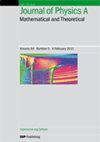The role of mobility in epidemics near criticality
IF 2.1
3区 物理与天体物理
Q2 PHYSICS, MATHEMATICAL
Journal of Physics A: Mathematical and Theoretical
Pub Date : 2024-09-17
DOI:10.1088/1751-8121/ad6cb6
引用次数: 0
Abstract
The general epidemic process (GEP), also known as susceptible-infected-recovered model, provides a minimal model of how an epidemic spreads within a population of susceptible individuals who acquire permanent immunization upon recovery. This model exhibits a second-order absorbing state phase transition, commonly studied assuming immobile healthy individuals. We investigate the impact of mobility on the scaling properties of disease spreading near the extinction threshold by introducing two generalizations of GEP, where the mobility of susceptible and recovered individuals is examined independently. In both cases, including mobility violates GEP’s rapidity reversal symmetry and alters the number of absorbing states. The critical dynamics of the models are analyzed through a perturbative renormalization group (RG) approach and large-scale stochastic simulations using a Gillespie algorithm. The RG analysis predicts both models to belong to the same novel universality class describing the critical dynamics of epidemic spreading when the infected individuals interact with a diffusive species and gain immunization upon recovery. At the associated RG fixed point, the immobile species decouples from the dynamics of the infected species, dominated by the coupling with the diffusive species. Numerical simulations in two dimensions affirm our RG results by identifying the same set of critical exponents for both models. Violation of the rapidity reversal symmetry is confirmed by breaking the associated hyperscaling relation. Our study underscores the significance of mobility in shaping population spreading dynamics near the extinction threshold.流动性在临界流行病中的作用
一般流行病过程(GEP)又称易感-感染-康复模型,它提供了一个关于流行病如何在易感人群中传播的最小模型,易感人群在康复后获得永久免疫。该模型表现出二阶吸收态相变,通常是在假定健康个体不移动的情况下进行研究的。我们通过引入 GEP 的两种广义,分别研究了易感个体和康复个体的流动性,从而探讨了流动性对疾病传播在临近灭绝阈值时的扩展特性的影响。在这两种情况下,包括流动性会违反 GEP 的快速反转对称性,并改变吸收态的数量。通过扰动重正化群(RG)方法和使用吉莱斯皮算法的大规模随机模拟,分析了模型的临界动力学。重正化群分析预测这两个模型属于同一个新的普遍性类别,描述了当受感染个体与扩散物种相互作用并在恢复后获得免疫时流行病传播的临界动力学。在相关的 RG 固定点,不动物种与受感染物种的动力学解耦,由与扩散物种的耦合主导。二维数值模拟证实了我们的 RG 结果,为两个模型确定了相同的临界指数集。通过打破相关的超尺度关系,证实了违反了快速反转对称性。我们的研究强调了流动性在形成灭绝临界附近的种群扩散动力学中的重要性。
本文章由计算机程序翻译,如有差异,请以英文原文为准。
求助全文
约1分钟内获得全文
求助全文
来源期刊
CiteScore
4.10
自引率
14.30%
发文量
542
审稿时长
1.9 months
期刊介绍:
Publishing 50 issues a year, Journal of Physics A: Mathematical and Theoretical is a major journal of theoretical physics reporting research on the mathematical structures that describe fundamental processes of the physical world and on the analytical, computational and numerical methods for exploring these structures.

 求助内容:
求助内容: 应助结果提醒方式:
应助结果提醒方式:


